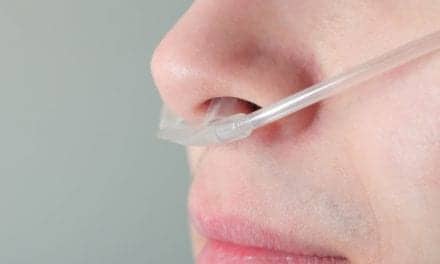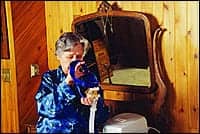 |
Spirometry. It is one of those health care tools a respiratory therapist might use every day, but few people outside of medicine could describe it, tell you what it does, or how important it is to RTs. Yet, like all technology, spirometers and their markets are changing and growing. To catch up on the latest trends in spirometry devices, RT interviewed representatives from three manufacturers.
 |
- Ralph Cook, RRT, RPFT, is the pulmonary product manager for Medical Graphics Corporation based in St Paul, Minn.
- Susan Lukenbill is the national sales manager at Futuremed America Inc, Granada Hills, Calif.
- Rich Rosenthal is the director of marketing and business development for nSpire Health Inc, based out of Longmont, Colo.
Each of these companies has been a developer and manufacturer of spirometry products for decades.
Futuremed was established in 1980. Since its beginnings, the company’s focus has been on spirometry products, which include pediatric spirometry devices, as well as software that interfaces its spirometers with electronic medical record systems.
Founded in 1977, Medical Graphics Corp designs, manufactures, and distributes cardiorespiratory diagnostic systems. In addition to spirometers, its products include pulmonary function systems, health care treadmills, and related device software for the management and improvement of overall health fitness.
In addition to developing and manufacturing a wide range of spirometers, nSpire Health is focused on cardiopulmonary diagnostics, respiratory core lab services, and disease management solutions designed to improve health care productivity and increase patient care. Over the years, nSpire Health has grown and merged with several health care companies, including Collins Medical and Ferraris Respiratory.
RT: Spirometers have a long history in the respiratory segment. Tell us about the venues and conditions for which RTs use spirometers today.
Ralph Cook: Spirometry is used as the basis for any complete pulmonary function test, but by itself can be used to indicate obstructive abnormalities and be suggestive of a restrictive pulmonary defect.
The advent of small portable spirometers has opened the field for where these devices can and will be used. From devices that simply measure FVC [forced vital capacity] and FEV1 [forced expiratory volume in 1 second] to spirometers that measure the complete list of variables, spirometers are used in just about any arena where knowledge of the pulmonary system is valuable. In addition, the use of spirometers is not limited to those subjects suspected of having pulmonary disease. They can also be an integral part of any occupational or health screening program. Physicians can better serve those under their care with the knowledge of their patients’ baseline spirometry values.
Susan Lukenbill: Spirometers have many applications, including the diagnosis of asthma, but also the monitoring of patients in the occupational setting. Spirometers are also used in fitness testing and sports medicine, assessment of a disability, monitoring lung transplant patients, and determining preoperative risk, and as a tool in encouraging smokers to quit. A comparison of pre- and post-treatment spirometry also allows a physician to verify the short- and long-term effectiveness of inhaled medications, including corticosteroids. Yet many patients are often prescribed such medication without follow-up testing.
Spirometry is also an accurate, fast, and noninvasive tool for early detection of COPD in seemingly healthy patients. But spirometers are still greatly underused; patients who are at risk for lung disease—including asymptomatic ones—could be screened during a regular visit to their primary care doctors or cardiologists.
Rich Rosenthal: As a general rule, RTs are trained in the proper use of spirometers in order to facilitate the enormous number of situations in which lung function must be measured in a hospital setting. Most pulmonary function laboratories require advanced CPFT certification, but often simple bedside or office-based measurements are performed by rank and file respiratory therapists.
RT: The AARC [American Association for Respiratory Care] recently issued new guidelines for infant/toddler pulmonary function tests. How do these guidelines affect current spirometry devices or the use of spirometry devices by RTs (if at all)?
Rosenthal: The AARC guidelines, recently issued for infant/toddler PFT, utilize passive systems such as [one of our products]. These guidelines are not attempting to define new functionality at the simple spirometry level of instrumentation.
Lukenbill: Spirometry relies on a patient’s cooperation and good effort, but this can be difficult for young children. Recently, manufacturers have been using animated or cartoon-like incentive displays to encourage children to blow into the spirometers.
But for very small children, the FVC maneuver is difficult to understand, and if the test is not performed correctly, the results are not accurate. A more passive method of testing this age group is to measure airway resistance. The child takes normal breaths in and out of a special sensor. A quick shutter briefly occludes the path of air. Data derived from the pressure differential in the mouth measured against airflow is used to diagnose asthma. Early and accurate diagnosis of asthma is important in effective treatment of patients and prevention of eventual complications. In the last few years, the interrupter technique has been the subject of numerous studies, and I believe that soon this technology will be a staple in evaluation of younger patients.
RT: What are the current challenges with using spirometry in infants and toddlers, and how are spirometry manufacturers addressing those needs in today’s devices?
Rosenthal: Current spirometry testing, even with the best coaching, has a lower age limit of about 3 years old, more often 6 or 7. The innovation, first introduced back in the 1980s by companies such as PDS and MultiSpiro, is animated graphical incentive displays, which make the test into a game, asking the patient to “blow out the candles,” “blow up the balloon,” “blow the boat across the lake,” or “make believe you’re the big bad wolf and blow down the three pigs’ houses.” As the computer technology improves, these animations and educational video instructions will also improve.
Cook: There are a limited number of variables that all spirometers can measure. There are even [fewer] variables that actually have meaning in the diagnosis of lung disease. Many clinicians want to see multiple variables every time they perform a lung measurement; however, the ATS/ERS [American Thoracic Society/European Respiratory Society] guidelines for interpretation focus on VC, FEV1, and the FEV1/VC ratio to help classify obstructive and restrictive diseases.
If most spirometers report the same variables, then the focus becomes the ease of use and infection control. With spirometers sometimes being in the hands of less qualified individuals, the system must be easy to use and also help guide the clinician to performing an acceptable test. Simply obtaining numbers is meaningless if those numbers are not accurate. By letting the operator know when an individual effort does or does not meet ATS/ERS guidelines, you increase the percentage of obtaining acceptable data. The adage “no data is better than bad data” is very true in lung function testing.
Once the data has been obtained, the next hurdle is to present it in a form that is meaningful to the interpreting physician. Whether this is in a printed report or via a physician review station where everything is performed on a computer that is networked or through the Internet, the format has to be configurable. You need to be able to present the necessary data and graphs so the physician can interpret the information in a timely manner. The format for one physician may differ from another and the software must have the ability to contend with this.
You also need to be aware of the implications of testing multiple subjects on the same system. The question to ask is: “Would you want to be the next subject on your system if you knew the previous subject had an infectious disease?” If the answer is no, then you need a system that will give you multiple options for infection control. Being able to change the flow device without having to wait for warm-up or recalibration is a major advantage. By having a system that allows you to either throw away the flow sensor, wash and reuse the flow sensor, or use a filter, the clinician can choose the method of infection control that suits their needs.
Lukenbill: Spirometers need to be able to interface with newer technologies in the physician’s office. As operating systems and [electronic medical record] software are updated, spirometers need to keep up to ensure continued compatibility.
RT: What are the latest trends/features in your spirometry devices, and how are these new features helpful to patients and/or RTs?
Rosenthal: Features continue to evolve in the spirometers of companies focused on this market segment. As discussed earlier, use of better animation, better use of audio and video, and clearer focus on ease of use for users who have not benefited from professional training will be added to most systems. New technologies to greatly increase accuracy and precision are under development, as well.
RT: Is the spirometry market growing? What market segments do you see the most growth in the next few years? Why?
Cook: I think the spirometry market is growing and will continue to grow for some time. There is a major push to have general practice physicians use spirometry to obtain a baseline for their patients. With a majority of these physicians not currently owning a spirometer, the demand for simple spirometers in physician offices will increase.
Also, with spirometers getting easier to use, the home market will continue to increase. Patients have the ability to measure peak flow, FVC, and FEV1 at home. As the population ages and with the increase in the incidence of respiratory disease, home monitoring can be an effective way to test a subject and transfer the data to a qualified physician.
Rosenthal: The trend will continue to adopt spirometry at primary care facilities. The need to diagnose and treat asthma earlier will continue to drive the pediatric market. Similarly, the need to diagnose, treat, and prevent via objective-based smoking cessation will drive more and more adoption in general medicine, internal medicine, and family medicine. Relative to other diagnostic tests, it is inexpensive, mostly reimbursable, quick to perform, and easy to learn.
RT: Are there funding issues for the use of spirometry in hospitals or home care?
Cook: Reimbursement for hospitals and home care is always an issue. If you don’t get paid for your services, many facilities will not offer a program. While spirometers are relatively inexpensive, salaries for qualified personnel and an effective quality control program must be accounted for.
Rosenthal: Of course, funding in a recessionary economy is always hard to come by, and the focus on preventive care is finally taking hold in the United States. Spirometry, which allows earlier diagnosis, is far less costly than treatment of advanced cases of lung disease. Lawmakers are fundamentally aware of this. The other advancement—although it requires changes in current funding philosophy—is to allow and pay for telehealth monitoring of lung health. Tools are soon to be available to do so at remarkably low cost, using readily available Internet-based technology.
RT: What is the future of spirometry? How will they be changing future generations, say 3 years from now?
Cook: The biggest issue is the ability of the technician to obtain technically acceptable and repeatable efforts. Until we get to a position where the system can literally instruct the subject and know whether the subject is performing correctly, the focus should be on educating the operator. With the push for spirometry in the physician office and many clinicians in all settings performing spirometry for the first time, education is a key element for the future.
Rosenthal: Incorporation of easy-to-perform resistance and gas exchange will come about at the price point of current spirometry. Although 3 years might not be the exact time course, the technology to perform such advanced measurements will surely come to pass.
Tor Valenza is staff writer for RT. For further information contact [email protected]









